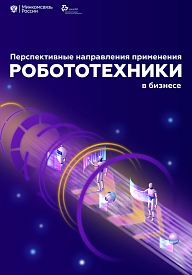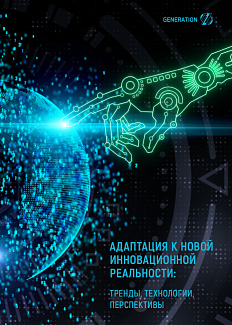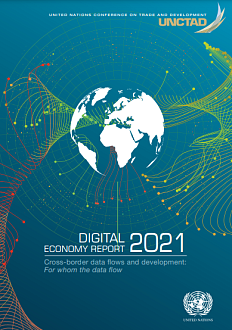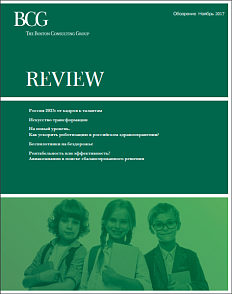The Ministry of Digital Development, Communications and Mass Media of the Russian Federation and the Russian Association of Robotics (RAR) present a joint study on promising areas of commercial application of robots. The publication contains a collection of case studies of robotic systems which are either operating or under development in various industries.
To prepare this overview, the Roscongress Foundation experts have analyzed the findings of the publication and presented its main points accompanied by fragments of broadcasts from the Roscongress information and analytical system. Such an approach makes it easier to navigate through the information and improves the effectiveness of searches on the portal.
Robotic systems are a tool with great potential.
Robotic technologies have earned a good reputation in many areas of human activity. In manufacturing, robotic systems are installed at production facilities to automate production processes. They are also used in emergencies to provide prompt help in a safe way.
Robotics is about process optimizationit saves time and money and delivers much better results. For example, robotic systems in car manufacturing shorten the production cycle, improve quality of the final product, and eliminate the factor of human error.
Depending on output and salaries of workers, automating a process with robot units can recoup the cost over 1 to 3 years. The released funds can be used to expand the product range, offer new services, or enter new markets.
Manufacturing is one of the most promising areas for robotic technologies.
Industrial robotics is a mature market, its technologies having been studied and implemented for more than 50 years. Over this time, industrial robotics has earned a reputation as an effective tool for reducing operating costs. It went mainstream in car manufacturing, electrical machine building and electronics, metalworking, mechanical engineering, and other manufacturing industries.
According to the International Federation of Robotics (IFR), the volume of industrial robots market in 2018 was 422 thousand robot units, or USD 16.5 billion in monetary terms. The industrial robotics market grew by 6% over 2017-2018.
In Russia, the degree of automation is below the global average. One of the indicators illustrating the use of industrial robots is robot density, or the number of installed industrial robots per 10,000 employees in the industry. This indicator reflects market saturation and the level of automation.
To expand the spectrum of areas where industrial robots and robotic manipulation technologies can be used, it is necessary to overcome a number of issues:
• Reduce cost. On the whole, robots are getting easier to operate and program, which makes them accessible to many companies, including small and medium-sized enterprises.
• Expand the spectrum of processes where robots can be used. Specialized software which makes it possible to automate robot programming, opens up new niches for application of industrial robotics.
• Develop machine vision and gripper systems. At the moment, the spectrum of actions which robots can perform is limited to tasks of the same type. Gripping versatile objects which differ in form and weight is a hard-to-implement function which is currently being worked on by the leading developers.
• Enhance collaboration. Equipping robots with sensors makes it safe to use robots in one space with humans. Also, its possible to equip collaborative robots with a training system based on memorizing manipulator motion. This facilitates human/robot interaction because this doesnt require any additional programming.
The crucial factors for the development of robotics are market demand and business integrators because industrial robotics is developing as a response to market needs, and not on its own. Thus, it is necessary to offer incentives to potential customers by informing them about best practices and cutting-edge technologies, offering retraining programs, and providing financing on preferential terms.
Robotic systems are growing in popularity in the agroindustry.
The growing interest in agricultural robots is determined by a number of factors, such as increasing ease of access to technologies, expanding areas of robot application, and the breakthrough in unmanned vehicles technologies.
The global market of agroindustrial robots expanded by 30% in 2018 compared to 2017. 477 agricultural robot units were sold. Market volume was USD 2.4 million. Experts estimate that in 2019 the global market for agricultural robots increased twofold compared to 2018. For 2020-2022, annual market growth is projected at 50%.
In agroindustry, robots above all help reduce costs associated with the human factor. For Russia, this is particularly important due to the following reasons:
• shortage of labor: robots can replace tractor drivers and combine operators and perform fertilization and harvesting tasks;
• costs associated with negligence or dishonest practices: a robot will neither skip its work shift nor steal fuel or harvest;
• challenging working conditions: even today, an autopilot on a tractor or a combine can do the driving, thus letting the operator concentrate on controlling the attached equipment;
• adverse weather conditions: a robot can work in cold or rainy weather and in poor visibility.
Medical robotics is one of the leading segments of professional service robotics in terms of technologies and demand.
The medical robots market has been developing for over 25 years. Medical robots improve the quality of medical manipulations through precise application of medical instruments for diagnosing and treatment, increase the accuracy and safety of surgical operations, and reduce the recovery period due to minimally invasive therapy and elimination of infections.
Medical robots also raise the economic efficiency of patient care, while medical training units facilitate the training process for medical personnel. Data collected by robots can be stored in cloud databases and used for analysis and prognostication.
Sales of medical robots reached 5,100 units in 2018, which is 50% more than in 2017. In 2018, medical robots accounted for 31% of the total sales value of all professional service robots. The market volume increased by 27%, reaching USD 2.8 billion.
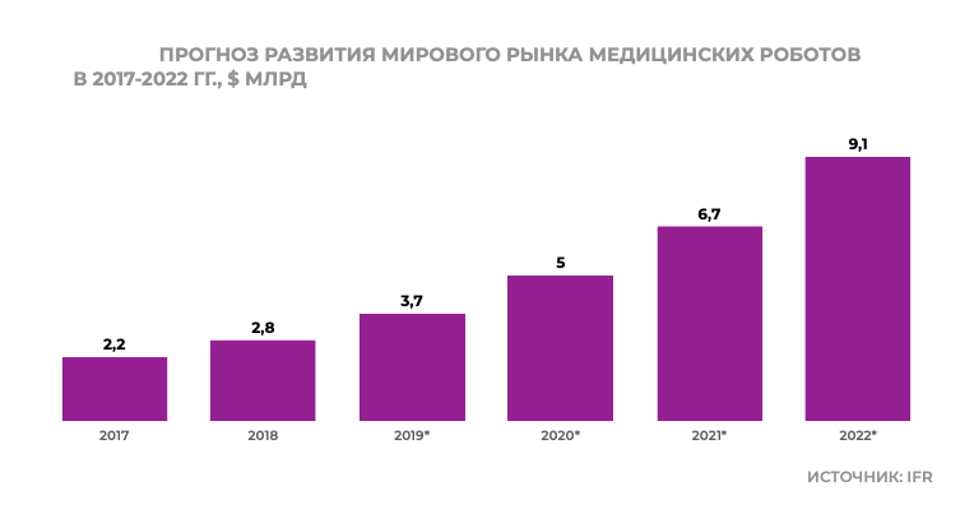
Medical robots are the most expensive type of service robots. An average price for a medical robot unit, including accessories and maintenance, is USD 548 thousand.
Video: https://roscongress.org/sessions/sberbank-venture-pulse/search/#01:13:12.959
Promising areas for application of robots in related areas and other industries
Industrial robots are also used in mining, construction, logistics, cleaning services, equipment monitoring and maintenance, emergency services and security systems, servicing of public spaces, moviemaking industry, and in designing exoskeletons.
Often, similar technical solutions can be applied in a range of industries. For example, industrial manipulators and robot units can be used not only in manufacturing but also in logistics and healthcare. Drones can be used in mining, logistics, construction, and for power lines monitoring. Thus, its important to adapt the currently existing technologies for specific use.
Video: https://roscongress.org/sessions/roboty-nadezhnye-pomoshchniki-lyudey/search/#00:27:19.168
For more information about Industry 4.0, innovation, and the latest R&D projects, please see the Robotics and Artificial Intelligence special sections of the Roscongress information and analytical system.


